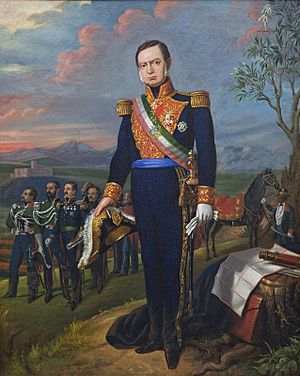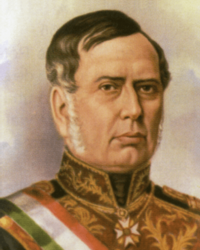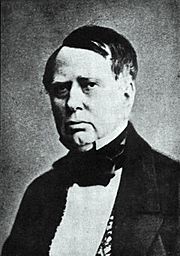Mariano Arista facts for kids
Quick facts for kids
Mariano Arista
|
|
|---|---|

Portrait made by Eduardo Pringet in 1851.
|
|
| 19th President of Mexico | |
| In office 15 January 1851 – 6 January 1853 |
|
| Preceded by | José Joaquín de Herrera |
| Succeeded by | Juan Bautista Ceballos |
| Minister of War and Marine | |
| In office 12 June 1848 – 14 January 1851 |
|
| President | José Joaquín de Herrera |
| Preceded by | Manuel María de Sandoval |
| Succeeded by | Manuel Robles Pezuela |
| Personal details | |
| Born | 26 July 1802 San Luis Potosí, San Luis Potosí, New Spain |
| Died | 7 August 1855 (aged 53) Lisbon, Portugal |
| Resting place | Panteón de Dolores |
| Nationality | Mexican |
| Political party | Liberal |
| Spouse | Guadalupe Martell |
José Mariano Arista (born July 26, 1802 – died August 7, 1855) was a Mexican soldier and politician. He became the President of Mexico.
He led Mexican forces during the first battles of the Mexican American War. These were the Battle of Palo Alto and the Battle of Resaca de la Palma. Mexico lost these battles badly. Arista was put on trial by the military but was found innocent. He continued to be important in the government. He served as Minister of War under President Jose Joaquin Herrera.
Arista later became president after Herrera. His start as president was special because it was the first peaceful transfer of power in Mexico since 1824. The time when Herrera and Arista were presidents, right after the Mexican-American War, was a period of peace and economic growth. A Mexican historian named Francisco Bulnes even called Arista one of Mexico's greatest presidents. However, Arista was removed from power after he made big cuts to the government budget. This made many people unhappy. The people who overthrew him brought Santa Anna back to power. This was Santa Anna's last time as a dictator. Santa Anna sent Arista away from Mexico. Arista died in Lisbon, Portugal, in 1855.
Contents
Early Life and Military Career
Mariano Arista was born on July 26, 1802. In 1813, he joined the military as a cadet in Puebla. He was part of different cavalry groups. The Mexican War of Independence had already started when Arista joined the army. At first, he fought for the Spanish King. He did so well that he became an officer in 1818. He was promoted to ensign in 1820 and lieutenant in 1821.
In 1821, he decided to join Agustin de Iturbide's Plan of Iguala. This plan aimed for Mexico's independence. On June 11, 1821, he joined the Army of the Three Guarantees. He brought many soldiers with him. He was part of the siege of Puebla in July 1821. He helped capture the city. For his excellent service, he became a captain ten days after Mexico City was captured. In December 1821, he was promoted to lieutenant colonel.
In 1823, he joined a movement against the First Mexican Empire. He was very dedicated to this cause. He helped the army that fought for freedom until it captured the capital city.
Mexico's First Republic
During the time when Mexico was forming its first republic, Arista fought against groups that rebelled against the government. In 1824, he fought in a battle near Apam. For his service, he was promoted to captain.
Five years later, he was a lieutenant colonel. He took part in rebellions against the election of Manuel Gomez Pedraza. He joined Santa Anna in a protest. When General Anastasio Bustamante rebelled against President Vicente Guerrero, Arista helped the uprising. He took the city of Puebla. President Bustamante favored him. Arista was promoted to colonel in 1831 and then to Brigadier General.
He fought against other uprisings against Bustamante's government. He helped defeat rebel forces in Lerma in 1832. He also helped bring peace to the Valley of Toluca. Later, Arista helped arrange a ceasefire. He signed the Convention of Zavaleta. This agreement transferred power to Manuel Gomez Pedraza.
When Valentin Gomez Farias and Santa Anna became vice president and president, Arista continued in the military. He was put in charge of security for travel to Veracruz. In 1833, he was ordered to fight rebels who wanted Santa Anna to be a dictator. However, Arista joined these rebels. He sent people to the capital to work against Gomez Farias. Arista became a target of the government. He fled to Guanajuato, where he surrendered. He was sent away from Mexico. He went to the United States. He returned in 1834 when the Plan of Cuernavaca overthrew Gomez Farias.
Centralist Republic of Mexico
Mexico was changing from a republic to a centralist government. Arista returned to Veracruz in 1835. He was arrested at first but later allowed to go to the capital. He was stopped again in Jalapa due to suspicions of joining a rebellion. But he was found innocent. The new government appointed him to the Supreme Military Court. He also became an inspector of militias.
When the Pastry War started in 1838, Arista was put in charge of a group of soldiers. Their job was to defend Veracruz. He learned that the French had captured San Juan de Ulua. He received orders from Santa Anna to advance on Veracruz. He entered the port on December 4. The next morning, the house where he and Santa Anna were staying was attacked by the French. Arista fought back but was captured. He remained a prisoner until January 28, 1839.
After the Pastry War, he helped stop rebellions across the country. These rebellions wanted to bring back the federal system. He led a group to attack rebels in Tampico. He pursued the federalist forces and got them to surrender.
Arista became the military commander of Tamaulipas. Then, he became the commander-in-chief of the armies in the north in late 1839. He reorganized his military area. He fought against rebels, driving them out of Monterey. He completely defeated them in the Battle of Santa Rita Morelos. He also helped prevent a riot in Tampico. With the country peaceful, he focused on preparing the army to defend against the Texas rebels. For the next five years, he led expeditions against Native American tribes and against Texas.
Mexican-American War
Arista was again the commander-in-chief when the United States took over Texas. As tensions grew between the U.S. and Mexico, Arista worked hard to secure the border. He increased his forces to six thousand men. However, President Mariano Paredes ordered him to step down from his command. Arista went to his ranch near Monterey.
But then, in April 1846, he received another order to return to his post. News arrived that American forces, led by Zachary Taylor, were heading to Matamoros.
After the Battle of Resaca de la Palma, Mexico's government removed Arista from command. He asked for a court-martial (a military trial). He was found innocent of any fault for the losses at Palo Alto and Resaca de la Palma. Arista spent the rest of the war working in government roles, but he did not see much combat.
Becoming President of Mexico
The presidential elections for 1851 began in late 1850. Arista, who was the War Minister and important in the previous government, was a leading candidate. Other candidates included former presidents like Manuel Gomez Pedraza and Santa Anna.
Some people criticized Arista for interfering in an election in Mexico City. But in the end, the states voted for Arista. He received thirteen out of nineteen possible votes. The next closest candidate got only three votes.
Arista became president on January 15, 1851. He made some changes to his cabinet (his team of ministers). He kept many of the policies from the previous president, Herrera.
Financial Challenges
Mexico had big financial problems. This was a major issue for Arista's government. The government's income was 8 million pesos, but it spent 26 million pesos. The goal was to reduce spending to 10 million pesos. To fix the country's money problems, Arista greatly cut the salaries of government workers. Some salaries were cut by as much as seventy-five percent. However, these cuts were not applied fairly, and some unnecessary spending continued. The Finance Minister, Manuel Payno, resigned because he disagreed on how to reduce the debt.
Four more finance ministers resigned in about a month. Finally, Manuel Piña y Cuevas became Finance Minister in May 1851. He suggested some new taxes to cover the deficit. But the states strongly opposed this idea. Congress did not push the matter. In August, Arista called a meeting of state governors to find better solutions. The governors criticized the government's management. They presented a new calculation that showed no deficit at all. This was based on an old rule from 1849. The governors offered to increase state contributions, but this did not help much with the deficit.
The government needed more power from a difficult congress to act on the new budget. This would require more budget cuts. The ministers resigned, and a new cabinet was formed. The government got some small agreements from congress. But the legislature was mostly inactive. Newspapers criticized this. Some journals even suggested that the government should dissolve congress, but they were arrested for this idea.
There were disagreements between the federal government and the states about money. While states struggled for funds, congress passed a rule to tax duties by eight percent. This money was for its members and treasury officials. States were also not paying their required contributions to the federal government.
The government made an agreement with foreign and local creditors. These creditors had complained about smuggling and unpaid taxes. Local creditors formed a group that wanted to be consulted on all customs appointments. This group was called the junta de credito publico. It had the right to appoint someone to watch customs procedures. In May 1852, an effort was made to pay off the country's internal debt. But the money set aside by the government was not enough to cover even two-thirds of the interest.
Because of the government's budget cuts, crime increased. This was because there were fewer police patrols. Also, government workers were paid less, which led to corruption. Smuggling was common in the northeast because the government had set very high taxes. People were unhappy with the federal government's policies. They felt burdened by soldiers who did not protect the region.
Revolts and Challenges
Revolts against the government started almost immediately after Arista was elected. However, the government managed to stop uprisings in San Luis Potosí, Veracruz, Tlaxcala, and parts of Jalisco in 1851.
In the northeastern areas, José María Jesús Carbajal gathered 500 mercenaries from Texas. He crossed into Mexico in September 1851. He was joined by 200 more troops. They took Camargo and marched on Matamoros. The local leader agreed to lower taxes. This led to American goods flooding Mexico, which hurt Mexican businesses. The government sent more soldiers against Carbajal. Despite the tax cuts, Carbajal continued to attack Matamoros. The local soldiers held their ground. News of government reinforcements made Carbajal flee back across the border on October 30. In February 1852, Carbajal tried another invasion. But the government was ready and pushed him back. The government also brought back the old taxes.
Ongoing revolts and rumors of revolutions made the government more careful. They made many arrests. Finally, the press was forbidden to criticize the government on September 21, 1852. However, the Supreme Court later declared this rule unconstitutional on October 13.
By mid-1852, Juan Clímaco Rebolledo led a revolt in Veracruz over financial policies. His ideas were seen as moderate. The Arista government told state authorities to negotiate with him, but they refused. In Mazatlán, there was an uprising about dividing the state. In Michoacán, there was an uprising against anti-church measures by Governor Melchor Ocampo.
The Plan of Jalisco
In Jalisco, Governor Jesús López Portillo was unpopular. He seemed to be a tool of the federal government. A scandal happened when he arrested a hatmaker named Jose Maria Blancarte. Blancarte was arrested for attacking a police officer. He was removed from the state militia, even though he had been elected as a colonel. On July 26, Blancarte took over the governor's palace. He formed a council. This council named Gregoria Davila as the new governor. They asked him to create a new legislature and change the state constitution. Blancarte kept the main military command. Portillo retreated with a few loyal soldiers and asked the federal government for help. But the government only sent unarmed negotiators. Meanwhile, Blancarte's movement grew stronger.
At this point, supporters of Santa Anna, called Santanistas, contacted Blancarte. They convinced him to make his revolt bigger. On September 13, Blancarte announced that Arista should be overthrown. He said Santa Anna should be brought back to help reorganize the government. Davila, who was the political leader, stepped down. He did not want to be part of a coup. Santanistas replaced him with General Yanez. A week later, a changed version of the plan was put under Jose L. Uraga, a military general. He was asked to replace congress with an assembly. This assembly would have two representatives from each state. Their job would be to elect a president, change the constitution, fix the financial and election systems, reorganize the army, and improve border defenses against Native American raids. When the government heard that Uraga was chosen as leader, they tried to move him away from Guadalajara. But Uraga resigned and agreed to join the revolution.
In late 1852, more ministers resigned. Mariano Yanez became Minister of Relations. Guillermo Prieto became Minister of Treasury. Former president Pedro Maria Anaya became Minister of War. As the Blancarte Revolt grew, an extra meeting of congress was called. They needed to consider a new request for help. This included a loan of three million pesos, extra taxes, and special powers for the president. A small amount of money was secured to support an army against the rebellion. Congress was worried because only half of the governors still supported the federal government. On December 16, 1852, Minister Prieto made a strong appeal to the lower house.
The federal government had lost the support of most of the country. In the northeast, Carbajal was invading again. In Sonora, a French adventurer was launching his own invasion. In December, the states of Tampico and Veracruz, which had important ports, declared their support for the Plan of Jalisco.
Government forces were pushed back at Guadalajara on December 15. Arista spoke to the chambers when they met for the new year. He resigned on January 5. That midnight, Juan Bautista Ceballos was called to the National Palace. He was told that he was now president. Former President Arista left the Palace early in the morning. He left his official resignation with the Minister of Relations. He went to his ranch. He said that being president was "a grave burden and a useless title" if it did not come with power and respect.
Later Life and Legacy
When Santa Anna returned to power, Arista was forced to leave the country. He was in poor health. He visited many cities in Europe. He finally settled in Seville, where his health got worse. He wanted to return to Mexico. He got on a ship to Lisbon. But as his health declined, he tried to go to Paris for medical help. He died on board the ship Tagus on August 7, 1855.
He was buried in the cemetery of San Juan in Lisbon. Members of the diplomatic community from England, the United States, and Mexico attended his burial. When the liberal President Ignacio Comonfort came to power, he honored Arista. He ordered that Arista's ashes be brought to Mexico to be buried with other presidents.
Images for kids
See also
 In Spanish: Mariano Arista para niños
In Spanish: Mariano Arista para niños






